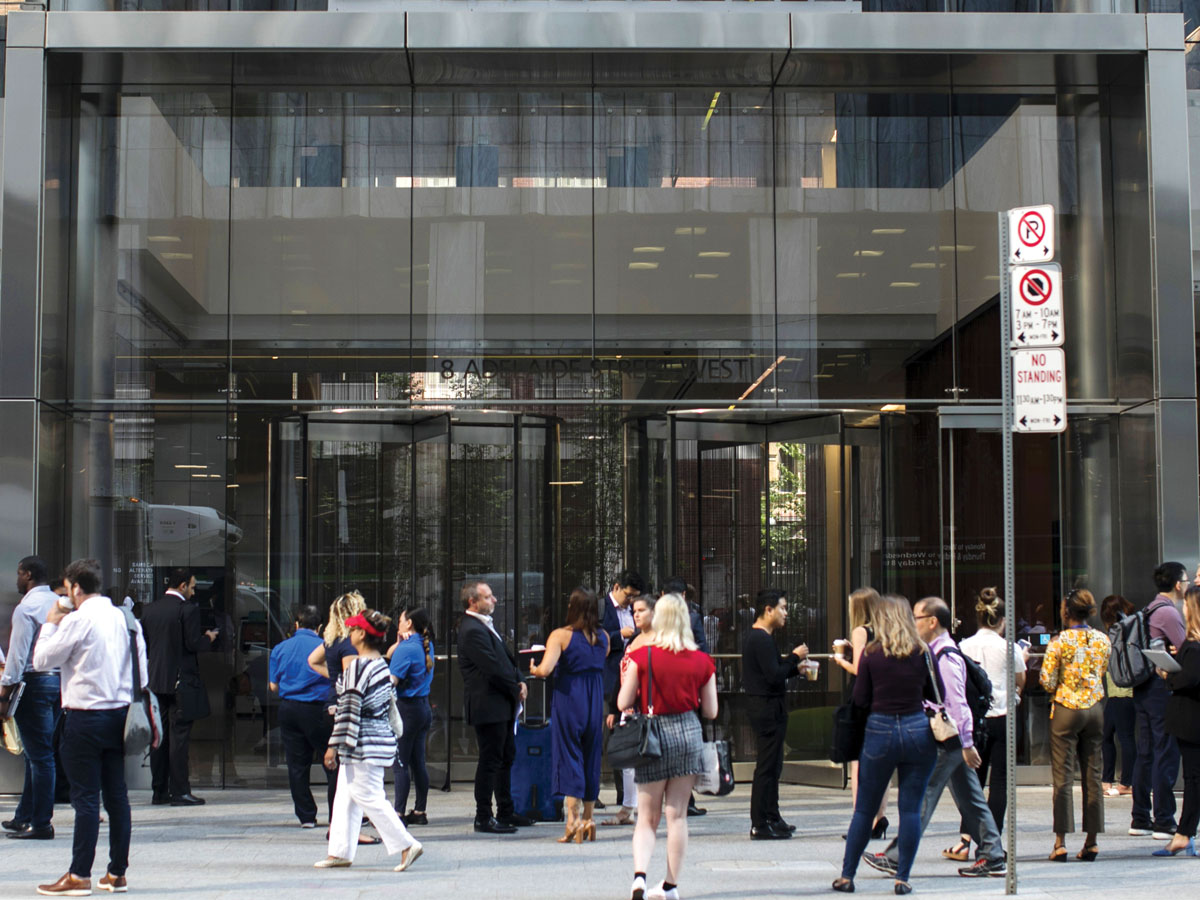
How #MeToo changed the workplace
 The greatest change wrought by Me Too is that women feel more comfortable reporting instances of workplace bullying and sexual harassment (Getty)
The greatest change wrought by Me Too is that women feel more comfortable reporting instances of workplace bullying and sexual harassment (Getty)
In 2002, Melissa Doyle was flying solo after the breakup of a long-term relationship and in desperate need of work. So, despite trepidations about working in a chemical production plant where women had almost no presence, she accepted a job as a plant supervisor at Zochem in Brampton, Ont. She had 11 years of prior experience as a manager, but nothing prepared her for the torment of relentless sexual harassment from the plant’s maintenance manager, Bill Rogers. Rogers would stare at and comment on her breasts—which he called “the girls”—and pretend to photograph them. He often suggested Doyle needed “a little pounding” or to “get laid.” Doyle put up with the abuse for nine interminable years. “I felt like I was in a prison,” she later recalled. “I thought, ‘I don’t know what else to do. I can’t go back to school. I’m by myself.’ ”
Doyle finally hit her breaking point in 2011. She had already reported the situation a year earlier, when Zochem hired a third-party company to conduct a survey about violence and harassment in the workplace. But nothing changed. So when a meeting with Rogers and Zochem’s chief engineer left her in tears, she reported the harassment yet again to the assistant general manager. On her next shift, she was fired.
Doyle fought back with a wrongful dismissal suit, but the psychological damage was done. When the case went to trial in 2016, the court heard she felt “betrayed, abused, sad and upset.” She was taking medication for anxiety and constant shaking. She had migraines and chest pains, and was kept awake by nightmares. She had already been struggling with depression, but after she was fired she was diagnosed with major depressive disorder. The case took seven years to settle, and ultimately the company was forced to pay for failing to provide Doyle with a safe work environment and to deal properly with her complaint. She was awarded the equivalent of 10 months’ salary, plus $25,000 for sexual harassment, $60,000 in “moral damages” for the way she was treated and, upon appeal, another $40,000 to cover her court costs.
Doyle is proud that she stood up for her rights. But she doesn’t consider her case a total victory. “I got the equivalent of two years’ pay,” she says. “He got to keep his job.” (Rogers has since left Zochem.) Today the case is referenced in employment law circles as a spectacular HR failure on every level—a corporate how-not-to guide for the Me Too era.
Since 2017, when several prominent women came forward with allegations of sexual harassment and assault against film producer Harvey Weinstein, there has been a paradigm shift in the way businesses approach workplace misconduct. A non-threatening and inclusive work environment is now considered so crucial from a reputational point of view that some companies are proactively disclosing how many harassers have been driven out of their operations. Late last year, in the U.K., Deloitte reported around 20 partners had been fired over the previous four years for inappropriate behaviour. That revelation pressured the other Big Four firms to disclose that they, too, had fired several partners for sexual harassment and bullying.
A December 2017 survey of high-level Canadian managers found 94 per cent believe sexual harassment is not an issue within their own workplaces
In Canada, harassment allegations forced media star Jian Ghomeshi from his CBC host’s chair and Albert Schultz from his position as artistic director of Toronto’s Soulpepper Theatre. Former CTV reporter Paul Bliss was fired after an investigation found he had repeatedly engaged in sexual misconduct with young women at work for more than a decade. But in contrast to the media and entertainment world, in the corporate sphere, most harassment complaints are settled privately and shrouded in confidentiality agreements. Except for the few cases that land in human rights tribunals or court, the public doesn’t hear about them. “We saw people in the business world disappear and we didn’t know why, but it was all happening at the same time,” says Karen Cook, a Vancouver communications consultant who specializes in crisis management.
The greatest change wrought by Me Too is that women feel more comfortable reporting instances of workplace bullying and sexual harassment. According to Ken Fredeen, general counsel for Deloitte Canada, this is causing a major cultural shift. “Before, this type of behaviour was seen as, that’s just the way men are, that’s the way it has to be,” Fredeen says. “Now they are being challenged, and that’s a wonderful thing.”
 In a 2018 poll, 34 per cent of women and 12 per cent of men reported being sexually harassed at work (Getty)
In a 2018 poll, 34 per cent of women and 12 per cent of men reported being sexually harassed at work (Getty)
Surveys show workplace harassment is still widespread. A Navigator poll of 2,000 Canadians from February 2018 found 34 per cent of women and 12 per cent of men reported being sexually harassed at work at some point. Of those, two out of five say the harassment “stemmed from a person who had direct influence over their career.” Only 59 per cent of respondents believe their organization has a culture where sexual harassment is not tolerated; fewer than half believe their workplace provides a safe person to disclose to, and only 49 per cent feel adequately informed about steps to take should harassment occur. A broader study released by Statistics Canada, as part of the 2016 General Social Survey, found 19 per cent of women and 13 per cent of men had experienced some type of workplace harassment over the past year. The most common was verbal abuse, followed by humiliating behaviour and threats. Four per cent of women said they had been sexually harassed at work within the past year. Women with disabilities and LGBTQ women are particularly vulnerable, says Fredeen.
And yet most corporate leaders minimize the problem reflected by these studies. A December 2017 survey of high-level Canadian managers found 94 per cent believe sexual harassment is not an issue within their own workplaces. The survey, sponsored by KPMG and conducted quarterly by the Gandalf Group, canvassed the views of 153 C-suite executives, 95 per cent of whom were men. Although nearly half agreed sexual harassment was rarely reported, they posited it was less of a problem now than years ago. The majority also felt sure their businesses already have appropriate policies and culture in place. In the U.S. this year, after EY partner Karen Ward filed a harassment and discrimination complaint, 67 New York state legislators sent a letter to EY CEO Carmine Di Sibio, denouncing the company’s practice of forced arbitration. But the firm has so far refused to revisit the policy.
The first step to stamping out sexual harassment is to ensure employees at every level understand exactly what the term means
This disconnect between employee experience and executive attitude suggests that despite the awareness brought on by Me Too, there is much work to be done. Companies that don’t rise to the challenge risk being outed by websites like Glassdoor, which allow past and current employees to anonymously rate their work experiences. Social media has shed light on harassment of all types, says Chris McKinnon, a former manager with the Ontario Human Rights Commission and the Ontario Ministry of Labour who now conducts independent workplace investigations with the consultancy group HR Proactive. He points out that victims who once felt isolated can now easily connect with others. “The generation coming into the workplace thinks a lot differently now,” McKinnon says. “They expect a diverse workplace where they’ll be respected and supported.” Fredeen agrees: “If you are truly interested in attracting and retaining the best talent there is, that requires an inclusive workplace.”
The first step to stamping out sexual harassment is to ensure employees at every level understand exactly what the term means. There are obvious transgressions, like groping, but sexual harassment can be much more subtle and subjective, and the purpose of workplace training is to ensure everyone understands where the line is. Sandra Corelli, a Toronto-based leadership coach and consultant, uses a spectrum developed by Kathleen Reardon, a bestselling author and professor emerita at the University of Southern California Marshall School of Business. It begins with a category labelled “generally not offensive,” which includes remarks made about someone’s hairstyle or dress. In the middle is “offensive,” which includes “gender-insensitive” remarks and being treated with condescension. At the highest end is “egregious sexual misconduct,” defined as coercion, sexual abuse or assault. Corelli finds the scale a valuable educational tool for employees at every level. It gives everyone a common language to categorize different levels of misconduct.
In workplaces where sexual harassment or bullying is a known problem, McKinnon begins his on-site education sessions by “reading the riot act.” You’ve got to try to impress upon people that times have changed, he says. And he points out that bullying can be more challenging to explain than sexual harassment. Also defined as psychological harassment, bullying encompasses behaviour that intimidates, belittles, isolates or humiliates an employee. “I used to have managers in my early days who thought that was effective management 101,” he says.
As organizations move to demonstrate that they take Me Too complaints seriously, there is some fear that innocent people will fall prey to false allegations. Now a CPA and partner at Hogg, Shain & Scheck, Ninette Bishay was an 18-year-old summer student at a different firm when she experienced a formative Me Too moment. A male colleague circulated a grossly inappropriate email about her to others in the office, and someone passed it on to her. She marched into her boss’s office with the offending missive and complained. Retribution was swift: her harasser was fired the next morning. Looking back, Bishay remains gratified her complaint was taken seriously. But today, as someone who occasionally advises clients on the importance of equitable anti-harassment and bullying procedures, she’s certain her harasser would be afforded more due process if the incident occurred now.
“I was harassed, don’t get me wrong,” Bishay says. “But I think a fair and rigorous process of investigation of complaints is expected in this day and age.” She shared her experience at a client seminar in October and contrasted it with a recent case where forensic accountant Dave Oswald, when faced with similar circumstances, unearthed an entirely different truth. Oswald was called into a workplace where a woman complained one of her male colleagues had harassed her with a barrage of emails, which grew increasingly sexually explicit. “She went to the HR manager with 50 emails, all printed out, and said, ‘I can’t put up with this anymore,’ ” says Oswald, owner of the investigation firm Forensic Restitution in Toronto. When confronted, her colleague adamantly denied writing them, and his computer showed no incriminating traces. He was placed on administrative leave and the company hired Oswald to examine the electronic trail. Although the woman said she had erased everything, Oswald recovered a few of the emails from her computer. “They had been sent and received from the same machine.”
Increasingly, firms are turning to outside investigators instead of relying on internal HR staff, who are often perceived as biased
Oswald’s discovery, though unusual, is nonetheless a cautionary tale for companies striving to create safe working environments. There is a fine balance between taking allegations seriously and maintaining fairness and due process. That is why Gillian Shearer, a Toronto lawyer and workplace investigator, is careful to avoid jumping to conclusions. Of the several harassment investigations she has done post-Me Too, she is positive a few were false. In one case that went public, Shearer says, “I don’t know if his marriage or professional life will survive.”
That’s not to lose sight of the fact that the majority of Me Too charges do check out. Increasingly, firms are turning to outside investigators instead of relying on internal HR staff, who are often perceived as biased. According to Ontario law, Shearer adds, the person investigating a potential harassment case cannot be subordinate to the accused party. Shearer starts her investigations by interviewing both parties—starting with the complainant—and potential witnesses to assess the severity and validity of the complaint. Creative companies don’t immediately yank an alleged harasser from their post, she says, but, depending on the seriousness of the allegations, instead find ways to let the person work from home or out of town while the inquiry is ongoing.
In cases where the harassment allegation goes public, companies often turn to crisis managers like Karen Cook in Vancouver. Cook advises clients to have a communications plan in place long before anything that would warrant media attention happens. These steps are especially challenging for small organizations with tight budgets, like many of the non-profits Bishay advises. Still, she encourages even the smallest business to include an anti-harassment statement in their core values, design sound policies and procedures, and pay to have them legally reviewed.
Me Too has broadened the conversation around appropriate workplace conduct, Fredeen says, and businesses need to be ready not just for more sexual harassment complaints, but also complaints about general harassment and bullying. The movement has given everyone a voice, and companies should respond by flushing out bad behaviour through education and dismissals. “It’s a very positive development,” Fredeen says. “And we’ve got to keep it moving forward.”